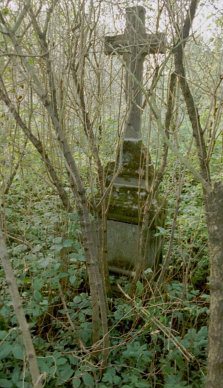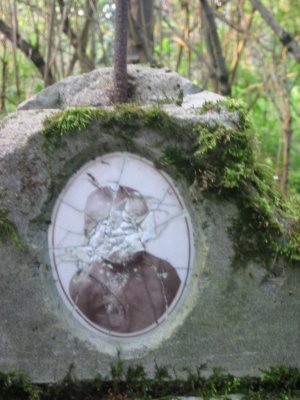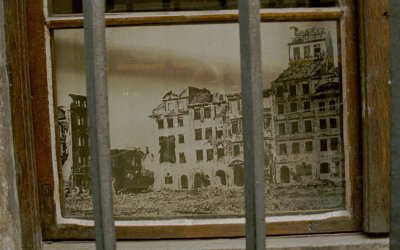 |
 |

|
Niedrunger Villagesby Annegret Krause - - translated by Paul Work | ||
|
Several barking dogs greeted us in a manner that wasn't exactly friendly. On the grounds, we met a young woman who assured us that this was indeed the old German church. A year was inscribed on the main gable. It looked like the church was built in 1935. In the mean time, an older woman emerged from the house. She appeared to be happy for the interruption and explained a little bit about the church. She said that the church was no longer in use, and very few people came to visit. Of course! After the Germans left, there were very few Poles who had converted to the Lutheran faith. Fewer still had been interested in using the church for religious purposes. Nie ma klucz, there is no key, she said. So we climbed onto a section of the wall and had a look inside the church through a broken window. Some of the interior had been cleared out, but the pews and a simple altar were still there. Hannes poked the camera through the window and blindly took a few pictures of the interior. The older woman had clearly enjoyed our encounter so Hannes took a picture of the two of us, and we took our leave. (Note: After the fact we learned that Wionczemin had once had a church made of stone. After the big flood of 1924, it developed a large crack, and they decided to rebuild from the ground up.)
H. and D., my American "cousins", who had sent me so much information about my family, will be very happy. Here lie, not only my relatives, but also theirs. Such a cemetery tells stories about the people who lived there. Many were children, who often died at an early age, many of diphtheria and in the 19th century also of smallpox. Many young people also died of tuberculosis. They had large families with many children, often more than ten. Frequently only half of them would reach adulthood. And the wives! They must have had a very hard life! Many died young, as did my great-grandmother at age 38, presumably at the birth of her 15th (!) child. One gravestone touched us especially deeply: Edmund Ratz, born 1924, died 1934.
Medaillon of Edmund Ratz - Photo by Annegret Krause, 2002 An inset oval should have carried a picture of him, but it had been destroyed. Youthful vandalism? Or an expression of hatred for everything German? We will never know. We found no other signs of deliberate destruction. Some gravestones were missing, but perhaps they were taken away simply to serve as a stair step or part of the foundation of a house for example. This cemetery was not a sad place, but rather a comforting one. The signs of the settlers have not been completely erased. These people are still here. They belong to this land just as much as the people who live here now. And that's the way it should be. A place without history is empty, without depth. Upon emerging, we looked like a pair of pigs, but we were very happy. We left the cemetery behind and set off to find Aunt Amanda's old farm. Her directions got us totally lost. Finally, on one path, we stopped, pulled out the cell phone, and called her at home: "Where are you?" "In Wionczemin, out in the fields. We found the cemetery and the graves of your grandparents!" She was totally overcome, and asked us to describe our location. She then told us exactly where to go from there. It seemed like she still had a photographic memory, even though she is 80 years old. And thus we finally arrived (at the Kaiserstrasse! - it's a gravel road that's still in use) at her old farm. Everything fits: the two ponds that were created when they built the mound to protect the house from floods (it's the highest mound in the village), the orientation of the house, the wood storage area, and the old trees. The old house has been torn down. It had been a solid structure built with five-inch timbers (as she had proudly explained to me). It has been replaced with an impressive stone house. All in all, this home gave us the impression of a flourishing owner – in stark contrast to the many others in the area. From this point, we should have been able to find the farm that belonged to the Krause family. It was supposed to be the fifth lot on the left side of the street. But it's getting dark; we'll have to come here again at some other time. And so we drove back to our accommodations, full of our experiences of the day. Friday, 4 October 2002Today, for a change, we traded our jeans and casual jackets for some upscale clothing and drove to Warsaw. It's only 45 km away on the main road. Shortly before the city itself began, the road transformed into a six-lane divided highway that followed the left bank of the Vistula straight into the old city. In the years since the fall of Communism, Warsaw has been transformed into a European metropolis. On the outskirts, we saw many new businesses and tall billboards. Here things are happening, here there is investment. No shabby tin huts, few makeshift structures here. The picturesque old town stands high above the banks of the Vistula. We had no difficulty finding it, and parked our car in one of the parking lots with a 24-hour watch. We let the flow of people carry us around, and the wonderful buildings astounded us over and over. The palace, the university, the splendid and richly decorated period homes on the Stary Rynek, the old town market. But all this glory is but an illusion. None of these houses is as old as it appears. The Polish capital was flattened to the ground at Hitler's order. Hardly one stone was left standing on the other. Old photographs, mounted unobtrusively in some of the windows reminded passersby of what had happened.
The destroyed Rynek - Photo by Annegret Krause, 2002 After the war, the old town was completely rebuilt with no detail left out. Old paintings by Canaletto were used as guidelines. The results astound the observer. The Polish restoration craftsmen rank among the best in the world. And again, just as we had in Danzig on an earlier trip, we asked ourselves: What drives some people to undertake such an enormous task? Especially during a time when, as we know all too well, the survivors had other worries on their minds: where the next meal was coming from, wondering what the next day would bring, and finding a roof to put over their heads. I read once what a priest from Danzig had said "A city must have a soul!" Is it really that simple? Perhaps. In a café on the edge of the palace grounds we met a congenial older couple from Johannesburg, South Africa who were making a trip through Europe. Prague, Bratislava and Budapest, some of the most beautiful cities on this continent, remained on their itinerary. They shared our enthusiasm. He was an architect, and he, an expert, reinforced our admiration. We felt so comfortable on our own that we declined to participate in any of the organized tours. There would be so much to see: The palace, Vilanova, Museums, the Praga on the other bank of the river, Łasienki Park, the area of the former Warsaw Ghetto. We decided to reserve an entire day for the sights. Unfortunately, nothing came of this. We'll have to go back on our next trip; I wouldn't mind that at all. We simply wandered through the city, taking in the atmosphere as we enjoyed the small streets, the views, and the antique and jewelry shops that were hidden behind the small windows. Nowhere was the façade broken with a large commercial window. Everything was consistent. Finally, we began looking for a bookstore so we could buy the topographical maps. We've wanted them for quite some time. In the third or fourth store, near the university, we found what we were looking for. The maps showed every path and almost every building in the villages we were interested in. I also bought two poetry collections, one by Julian Tuwim and one by Wisława Szymborska, whose stark verses I enjoy so very much. She received the 1996 Nobel Prize in Literature for her lyric poetry. Poems represent a wonderful chance to get to know another language more closely. Late in the afternoon, we finally reached our limit. Our heads couldn't take in anything more, and so we drove back in the soothing stillness along the levee. That evening, I chatted with K. in the warm snug kitchen with a cup of tea. We talked about Warsaw, and the trend towards a more western style, which she doesn't like: The high-rise buildings, the blaring advertising, Coca Cola, McDonald's, and IKEA. She described the tranquil life in Secymin. It's so peaceful here, she said. Yes, we agree. Saturday, 5 October 2002Oh these misleading maps! It was so exciting to look over the maps that we had purchased in Warsaw, so we let them tempt us into another "archeological" expedition. We found quite a few locations on the maps marked as "Cmentarz kolonistów" (colonist cemeteries) in the villages we were interested in. Among others, we found one for Sladów, which B. had mentioned, but it was located somewhere else in the village from where she had thought. We hadn't planned to get this deep into the research on this trip, but now we had itchy fingers. We asked William, the Dutchman, if he thought we were a little crazy. Not at all, he replied. He had a great big tolerant heart, and if two slightly idiotic teachers from Germany had nothing better to do during their holidays than crawl around Polish cemeteries, then that was fine with him. Unfortunately the weather had turned on us. The rain fell in a fine mist almost the entire day. We hoped for a break in the clouds and watched S. for a while as he worked making cheese. In his small dairy production, every piece of cheese was made by hand. It took 10 liters of milk to make each block of cheese. First, he let it ferment, and then he pressed the liquid out by hand. Every drop of moisture must be removed, as well as any remaining fat. The result is a wonderfully fresh block of cheese that weighs about one and one-half kilos. Some of them are smoked to produce an especially fine variety. In the mean time the weather hadn't improved at all, so we gave up waiting and began our explorations anyway. S. had told us last night that the Catholic priest in Secymin had begun to restore the old German cemetery there. We found the cemetery without any problems on top of a hill next to one of the entrances to the village. In the cemetery, the undergrowth had been cleared away from the gravestones, and they were clearly visible from the road. Unfortunately, very little was left intact. I found a few familiar names, but none from my immediate relations. In the back of my mind I had hoped to find the graves of my father's three siblings who had died very young. I had also hoped to find the grave of my great-grandfather. But we weren't completely disappointed. We were grateful that someone (who was a Pole, and a Catholic, what a wonderful gesture!) had cared for this site. A proper wall was under construction, and several corner posts made of brick were already in place. Our next stop was Sady, a neighboring village to Wionczemin. This time, we approached by way of Piotrkówek und Zyck. My great-grandmother was born in Sady, and my great great grandparents had lived here: the Gatzkes, Dobslaws and Gurskis. According to the map, the cemetery lay somewhere in a field near a small stream. Unfortunately, the map didn't show any roads or paths that led to the site. That meant that we had to go searching again. We found the stream, and we hiked over some fields, searching through some underbrush as the thick soil clung to our shoes (which are already soaked through), but we didn't find anything. Finally we asked a woman who appeared on a bicycle (carrying a milk canister) if she knew where the old German cemetery was. "Certainly!" came the immediate answer. Everyone we asked knew where these places were. It's in the "middle of the village" she said and pointed off in a direction. In the middle of the village, that was really funny! We only saw individual homes scattered across the landscape. We had no idea where one village ended and where the next one began. Where then would the middle of the right village be? But we were undaunted, and we turned off the main road into a path that took us to a farm. Barking dogs greeted us, and a friendly young woman came out of the house. We asked about the cemetery, and an older woman came out of the house. She sent us behind her farm across a wet pasture. She pointed out a run-down wooden building on the next hill. The cemetery should be next to this house. |


